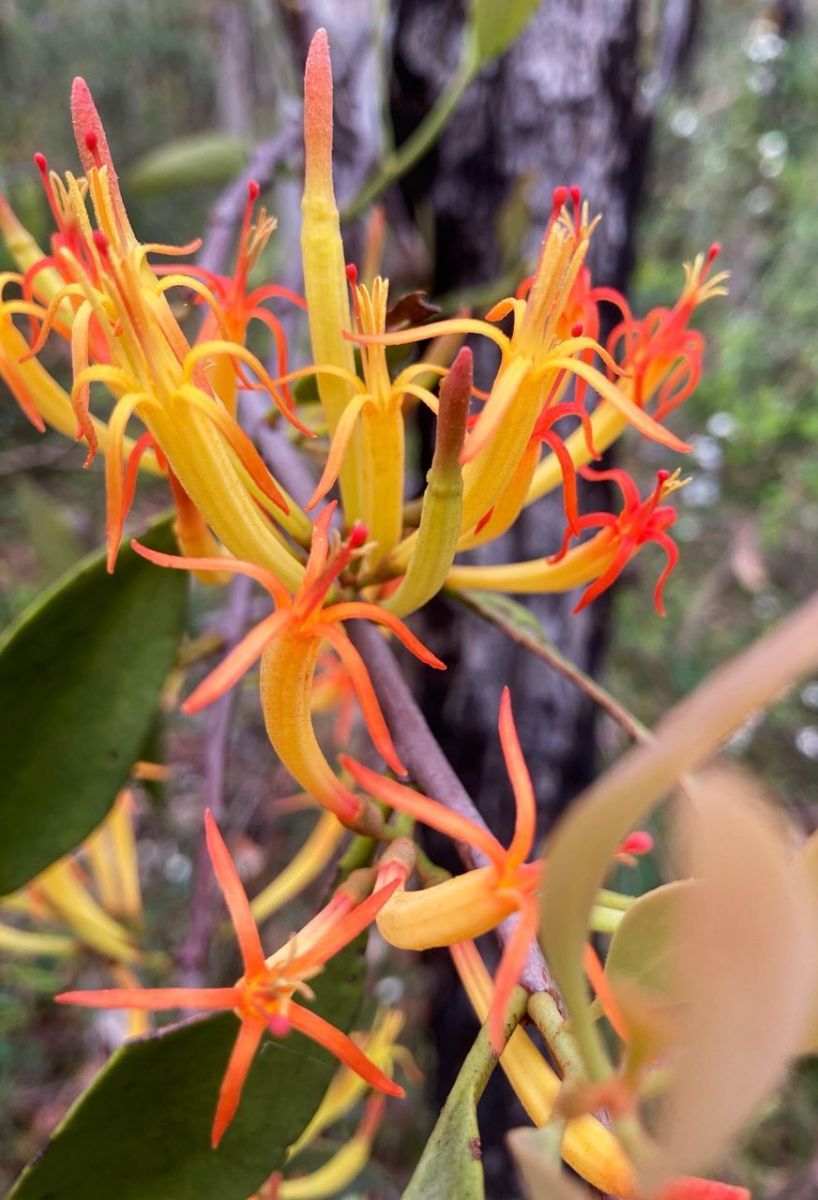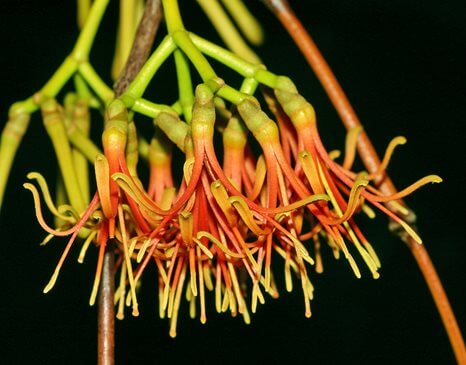The more you learn about something, the more you might change your views about it and mistletoes are no exception.
Mistletoe in European and Asian folklore refers to one particular plant, Viscum album. Thinking about mistletoes more broadly as perennial flowering plants with a shrub or vine habit and growing as parasites on the branches of shrubs and trees gives us about 1,400 species distributed across the world. There are about 90 species found in Australia. Mistletoes evolved over 30 million years ago in the part of Gondwanaland containing what is now Australia and were spread from there exclusively by birds. They are often thought of as parasitic plants that kill their host. Seeing isolated dead trees that show signs of past, heavy mistletoe growth in our semi-cleared landscapes might suggest that mistletoes are the culprit. However, this site is showing us more the problem than the cause. In reality, while mistletoes are part-parasites, they provide a wide range of services that support habitats and ecosystems and have great environmental (and agricultural) benefits.
Australian native plant societies have had their eye on mistletoes for quite a while. Marion Jarratt wrote about them in 2008 and, more recently in 2021, Peter Vaughan has given talks to NSW Australian Plant Society groups about them. As native mistletoes are found across Australia, except in Tasmania, there are, no doubt, other contributions. One of the main attractions of mistletoe for plant-lovers has to be their attractiveness as plants!
The images here (and quite a few more in Peter Vaughan’s video) highlight mistletoes’ visual appeal. Many mistletoes can be very specific about what host plants they will grow on, while others will grow on a variety of hosts, so there is quite a variety to choose from.



Mistletoes cannot be grown as seedlings and then planted out. They depend on birds to spread their seed (some depend on insects). Birds which feed on mistletoes often have feeding behaviour specifically suited to that plant. They can nip the end off a mistletoe fruit, squeeze the seed out, then swallow the seed, digest the sugary seed coating and excrete the remains, by which time they may well be in another tree. The excreted seed, which remains sticky, adheres to a tree branch and begins the germination process. The mistletoe bird is well-known for this but some Australian honeyeaters are also fond of mistletoe.
Research scientists from the Gulbali Institute, together with City of Melbourne staff, ran a trial to reintroduce mistletoe into Melbourne’s CBD trees. This involved wiping 900 (sticky) seeds onto the branches of 28 London plane trees around the city, replicating what mistletoe birds do. This is the method you need to use to propagate them.
Peter Vaughan talks about the problem of doing this up a ladder, where both hands might be needed for handling seed and you don’t have another hand to hold on with! Where there’s a will, there’s a (safe) way, as he explains in his interesting talk. Five years on, the Melbourne project has resulted in seven mistletoe plants becoming established in five trees, with two of those plants bearing fruit. The main challenge in this project was possums, which love to eat mistletoe leaves. The answer to this was having possum collars around the tree trunk to prevent possums climbing up into the tree. This project has inspired other projects to reintroduce mistletoe, for example, a project to boost populations of the endangered regent honeyeater in the Lower Hunter in NSW.
Possums love mistletoe because the leaves are quite succulent and have many nutrients and this is why many other organisms feed on them: gliders also feed on the leaves, 33 Australian bird species feed on the fruit and 41 on the flowers; many invertebrates (beetles, spiders, caterpillars, moths and butterflies) also feed on them. Over 200 bird species nest in them. Mistletoes also enrich the ground leaf litter, encouraging a healthy population of arthropods in the litter and soil. This, in turn, provides food for birds and other organisms that feed on these arthropods and so, strengthens the links between above-ground and soil processes in the ecosystem.
Mistletoes are very important plants ecologically, attract birds and other wildlife and are attractive plants in their own right. David Watson’s and others’ work is turning the tide so we don’t see mistletoes as undesirable parasites but as attractive components of our flora and keystone ecological species. They can even be desirable plants for our own gardens.
